With outdoor dining and socialising having been encouraged as the UK takes steps to exit lockdown, picnics are more appealing than ever. But whether your ideal picnic includes an impromptu meal deal or a well organised hamper of treats, preparing the perfect picnic can be tricky. Sandwiches with soggy bread, hard boiled eggs with chalky yolks, melted chocolate, or sticky fruits that attract flies: neither are particularly desirable. Instead, why not take a look at our selection of the best picnic recipes for summer and beyond.
10 of the best picnic recipes
Asparagus quiche
With a shortcrust pastry base, this seasonal asparagus quiche also features smoked steaky bacon, gruyère cheese, and thyme.
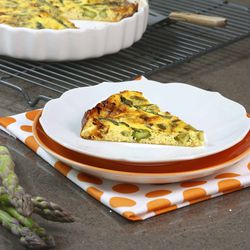
Asparagus quiche
Equipment
- 25cm pie dish, or fluted tin.
- Baking beans or a suitable alternative
- Pastry brush
Ingredients
For the pastry
- 125 g cold butter diced
- 250 g plain flour
- 1 egg
- ½ tsp salt
For the filling
- 200 g smoked streaky bacon cut into 1cm strips (optional)
- 12 asparagus spears trimmed
- 70 g gruyère cheese grated
- 4 large eggs
- 150 ml double cream
- 2 sprigs thyme leaves picked
- 2 shallots sliced
- A pinch ground nutmeg
- A knob of butter
Instructions
- Grease the pie tin with butter, or with a neutral oil and a pastry brush, and set aside.
- To make the pastry, add cold butter to flour and salt and rub in between fingers. Or use a food processor. (I run my wrists and hands under cold water to cool them down first). Rub the butter, flour and salt until they resemble breadcrumbs; some small, some the size of peas.
- Separate the egg and reserve the white, pour the yolk into a well in the centre of the mixture. Keep mixing and add very cold water, tablespoon by tablespoon, until it just comes together in a ball. If using a food processor, do this part by hand.
- Tip the pastry onto a piece of cling film and use the cling film to bring it together into a disk. Refrigerate for at least 30 minutes.
- While the pastry is chilling, use this time to prep the filling ingredients. Melt a knob of butter with a small amount of olive oil in a frying pan and sweat the shallots on a low/medium heat until soft and caramelised, this should take 10-12 minutes. In another pan, fry the bacon until crispy, then remove, leaving the bacon fat in the pan.
- Using a tablespoon of the reserved fat (remove and save any surplus for another recipe), sauté the asparagus with a pinch of salt and pepper for 3 minutes until softened but still crisp.
- Dust a work surface with flour and roll the pastry into 0.5cm/ ¼ inch thick. Roll the pastry up over the rolling pin, place the pan in front and unroll the pastry on top.
- Lift and drop the pastry into the edges of the tin, don’t push and stretch the pastry as this will create tears. A ball of leftover pastry can be used to help mould the pastry into the edges. Trim the edges of the pastry and crimp if desired. Chill in the fridge again for at least 30mins. During this time, preheat the oven to 200C/gas 6. Add a baking sheet to the oven at this point, giving it time to heat up. Rest the pie dish on this while cooking to prevent the base from becoming soggy.
- Once chilled, prick the bottom of the pastry all over with a fork, then fill with baking beans or a suitable alternative. Place on the preheated baking tray and bake for 20 minutes. Take out of the oven and remove the baking beans. Take the reserved egg white and using a pastry brush, lightly coat the inside of the pastry shell and bake for an additional 5-7 minutes, just until the pastry no longer looks wet, but not allowing the edges of the crust to brown too much. Adding an egg wash barrier between the custard and the pastry helps to prevent the custard from leaking.
- Reduce the oven to 180C/gas 4.
- Allow the pastry to cool slightly while you make the custard. Whisk the eggs, nutmeg and cream together with a generous pinch of salt and pepper.
- Evenly spread the bacon, shallots and ¾ of gruyère over the base of the pastry. Pour the custard over and sprinkle with the remaining gruyère and thyme. Bake for 15 minutes, or until somewhat set. Alternatively, place the pie tin in the oven without the custard and pour the custard over inside the oven to avoid spillages, cover with cheese and thyme as normal.
- After 15 minutes, remove from the oven and arrange the asparagus on top. Place them with the tips all facing outwards, like the points on a clock. Place back into the oven for an additional 7 minutes, or until the filling is softly set.
- Allow to set for 10 minutes before removing from the tin.
Notes
Filo pastry parcels with feta, couscous, and dates
These filo pastry parcels are a great picnic sandwich alternative, filled with feta cheese, couscous, and Medjool dates.
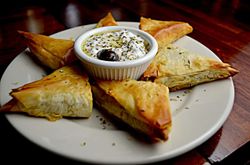
Filo pastry parcels with feta, couscous, and dates
Ingredients
- 100 g butter
- Filo pastry sheets
- 150 g natural yoghurt
- 2 tbsp honey
- Poppy seeds
- Pomegranate seeds for decoration
- 150 g feta
- 8-9 dates
- 1 cup couscous
Instructions
- Boil a kettle and put a cup of boiling water on top of the couscous. Cover the couscous and let it sit for four minutes.
- Melt the butter.
- Cut the filo pastry sheets thinly and crumble some of the feta, roughly chopped dates, and couscous on top.
- Diagonally fold the top right of the pastry to the bottom left of the filling and wrap it with the bottom section of the filo, folding over the remaining pastry to form a triangle shape, leaving a flap at the bottom.
- Spread melted butter on the remaining flap to seal, and fold into the parcel.
- Cook in the oven for 25 minutes at 180C/Gas 4 until golden brown and sprinkle with poppy seeds.
- Mix the natural yoghurt and honey and eat the parcels with pomegranate seeds.
Cacio e pepe arancini
A take on the Roman pasta dish, cacio e pepe (pecorino and pepper), chef Emily Roux’s cacio e pepe arancini recipe borrows from the Venetian tradition of breading and deep-frying leftover risotto. Here, the sauce element of the pasta dish is combined with risotto rice and made into arancini that’s portable, filling, and easy to eat at a picnic, without need for additional sauce or seasoning.
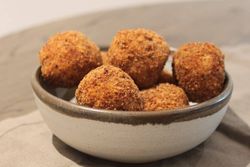
Cacio e pepe arancini
Ingredients
For the risotto
- 300 g carnaroli rice
- 70 g unsalted butter diced
- 80 g grated pecorino
- 50 g grated parmesan
- 2 g crushed black peppercorns
- 500 ml water to cook the rice
For the breading
- 2 large eggs beaten
- 4 heaped tbsp breadcrumbs
- 3 heaped tbsp plain white flour
- Salt to taste
- 500 ml sunflower oil to shallow fry
Instructions
- Bring a large saucepan of water to the boil.
- Toast the rice in a large saucepan (no need for butter or oil at this stage) stirring continuously until the rice itself is hot. Add a generous pinch of salt followed by the first ladle of water. Keep stirring vigorously. Let the rice absorb the water before adding another ladle full. Cook on a gentle simmer adding more water as and when needed.
- After a total of 18 minutes, all water should be completely absorbed by the rice. Remove the risotto from the heat and vigorously beat in the butter, pecorino, parmesan and peppercorns with a wooden spoon. Continue stirring until all ingredients are fully melted and the risotto is sleek and glossy.
- Pour the cooked risotto in a large shallow dish/container and leave to cool (ideally overnight in the fridge).
- When completely cooled and firm use your hands to create and shape small rice balls of 5-6cm in diameter. Once all the rice balls are shaped, put the breading ingredients into three shallow dishes. Then repeatedly dredge each ball in flour, followed by beaten eggs and finally coat in crisp breadcrumb.
- Heat the sunflower oil in a large frying pan. When the oil is nice and hot, shallow fry the arancini balls until crisp and golden brown on the outside.
- Once cooked, remove from the pan and place on absorbent paper to remove any excess oil.
Notes
- A very versatile recipe that can be tweaked for each season (why not try asparagus arancini in spring or fresh peas arancini in summer).
- Once breaded you can keep them in the freezer and fry them as and when you need. Perfect for a last-minute adventure.
Eccles cake
A classic British dessert, Eccles cakes are relatively simple to make at home and are highly portable. Best enjoyed with a wedge of Lancashire cheese.
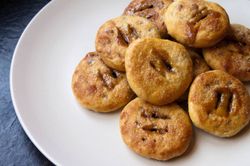
Eccles Cake
Equipment
- Baking trays
- Greaseproof paper
- 12cm round cutter
- Pastry brush
Ingredients
- A sprinkle of Demerara sugar
- 375 g puff pastry
- 1 egg white only, for egg wash
- Flour for dusting
For the filling
- 30 g butter melted
- 65 g dried cranberries
- 40 g dried apricots
- 45 g apple peeled and finely diced
- 60 g light brown sugar
- 30 g dark brown sugar
- 1 tsp ground cinnamon
- ½ tsp ginger
- 1/8 tsp clove
- 25 g crystallised ginger
- 25 g candied peel
- 1 orange all zest and 1tbsp of its juice
Instructions
- Start by preheating your oven to 200c/400f/gas 6.
- Combine ingredients for the filling and set aside until needed.
- On a floured surface, lay the puff pastry and roll so it’s extra thin, it should be 1.5mm/2mm in thickness.
- Use the cutter to cut as many rounds as the pastry will allow. When re-rolling the pastry scraps, make sure to lay the pastry pieces on top of one another (rather than bunching into a ball) as this helps keep the pastry flaky.
- Scoop a teaspoon of the fruit filling into the centre of each circle. Wet the perimeter of the circle with a damp finger, and pinch the edges of the pastry together to cover the filling. Flip the cake over so the smooth side is facing up, and using your hands and a rolling pin, press and roll out the cake until it's a larger circle and the fruit peeks through the pastry. Repeat for the rest of the pastry and filling.
- Place the cakes on a baking tray and, using a sharp knife, cut three slits. Brush with egg white and sprinkle with Demerara sugar.
- Bake for 15-20 minutes until golden and flaky.
Honey chicken thighs with garlic, chilli & thyme
These chicken thighs are simple to prepare, delicious cold, and also suited to being served in sandwiches. We recommend either crusty bread or soft rolls, joined by a little shaved parmesan, your lettuce of choice, and even a spoonful of coleslaw to take your picnic to the next level.
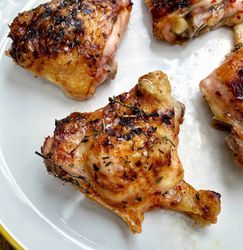
Honey Chicken Thighs With Garlic, Chilli & Thyme
Ingredients
- 4 chicken thighs skin-on
- A pinch smoked salt available in most supermarkets, but normal salt can be used as an alternative
- 4 garlic cloves
- ½ lemon cut into wedges
- Honey to taste
- 4 sprigs thyme (alternatively use 2 tsp dried thyme)
- Chilli flakes to taste, alternatively use black pepper
- Rapeseed oil or other neutral cooking oil
Instructions
- Preheat the oven to 180C/Gas 4.
- Pour a little oil over the base of a roasting tin or tray large enough to hold the chicken thighs.
- Place the chicken thighs in the tin, skin-side up, and season with a generous pinch of the smoked salt.
- Cut the ends off of each garlic clove, remove the white paper-like skin, but keep as much of the purple skin as possible, as this will prevent the garlic cloves from burning. Place the prepared garlic cloves into the roasting pan with the chicken.
- Add the lemon to the roasting dish, then drizzle some honey all over the chicken skin. Finish with the thyme and a pinch of either chilli flakes or freshly ground black pepper, to taste.
- Drizzle a little oil over all of the ingredients then roast in the oven for 35-40 minutes until the chicken skins are golden and the thighs are cooked through.
Twisted’s caponata mozzarella sandwiches
From Twisted: A Cookbook’s picnic chapter, these focaccia sandwiches are filled with Sicilian caponata, buffalo mozzarella, and an optional handful of anchovy fillets.

Twisted’s Caponata Mozzarella Sandwiches
Equipment
- Deep, heavy saucepan
Ingredients
- 2 small aubergines
- 3 celery sticks trimmed and sliced on an angle into 1cm chunks
- 4 tbsp good olive oil plus extra for dressing
- Neutral oil for deep frying
- 2 red onions sliced into half moons
- 2 fat cloves garlic thinly sliced
- 400 g can whole plum tomatoes drained
- 2 tbsp salted capers rinsed and drained
- 50 g black olives pitted and torn
- 2 tbsp white sugar
- 4 tbsp red wine vinegar
- 40 g pine nuts toasted
- A handful basil leaves
- Salt to taste
To serve
- Rosemary and Garlic Focaccia another recipe from the book in the Basics section, but other focaccia can be used
- 2 good-quality buffalo mozzarella balls
- Sea salt flakes to taste
Instructions
- Cut the aubergines into 3cm chunks. Toss well with some salt and place in a colander or sieve to drain for 1 hour.
- Meanwhile, bring a saucepan of very well salted water to the boil, add the celery and blanch until tender to the bite, 2-3 minutes. Drain, dress with a little olive oil and set aside.
- Thoroughly rinse the aubergines under running water, then pat very dry with kitchen paper.
- Heat a 5cm depth of oil in a deep, heavy saucepan to 175 degrees Celsius. Working in batches, fry the aubergine pieces until golden brown, about 5 minutes. Drain on kitchen paper and set aside.
- In another saucepan, heat the 4 tbsp olive oil over a medium heat, add the onions and fry until they are translucent and have collapsed a little but are not browned. Push them to one side and allow the oil to run to the other side of the pan. Reduce the heat a little, add the garlic and fry until sticky but not coloured, then chuck in the blanched celery and stir to incorporate.
- Turn the heat back up to medium. Crush the drained tomatoes in your hands and add them to the pan with a small pinch of salt. Cook for 10 minutes or so, stirring often to make sure nothing catches, then add the capers, olives, sugar and vinegar. Cook for another 1 minute or so to marry the flavours and dissolve the sugar, then remove from the heat. Stir through the fried aubergines, pine nuts and basil and allow to cool.
- Transfer to a container and drizzle with a little more olive oil.
- Slice your focaccia in half and load with the caponata. Tear over the mozzarella and sprinkle with a little flaked salt.
Tottenham cake
This traybake with lurid pink icing is simple to make at home the night before your picnic and is easy to portion. Moreover, Tottenham cake is also delicious.
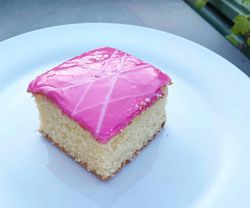
Tottenham Cake
Equipment
- 30 x 20cm baking tin
- Electric mixer (optional, but useful)
Ingredients
- 300 g self-raising flour
- 2 tsp baking powder
- 4 medium eggs
- 225 g unsalted butter
- 225 g caster sugar
- 1 tsp vanilla extract
- 1 orange zest only
- 3 tbsp milk plus extra, if needed
- 120 g mulberries or raspberries
- 300-350 g icing sugar
Instructions
- Preheat the oven to 180°C/Gas 4.
- Grease and line a 30 × 20cm baking tin with greaseproof paper.
- Ideally using an electric mixer (but a wooden spoon will do, if need be), mix the butter and sugar until creamed.
- Add the eggs, one at a time, and mix to combine. Stir in the vanilla extract and orange zest, then fold in the flour and baking powder. If the cake batter is too thick, add the milk one tablespoon at a time and mix.
- Transfer the cake batter to the baking tray and bake for 30-35 minutes, until a cocktail stick inserted into the centre comes out clean. Leave to cool in the tin.
- While cooling, heat the mulberries or raspberries with 2-3 tablespoons of water until soft. This will take around five minutes. Once soft, pass through a sieve into a clean mixing bowl, using the back of a spoon to squeeze out as much juice as possible. You should have around 5 tablespoons of liquid. Add a little cold water if necessary.
- Add the icing sugar, one tablespoon at a time, and whisk. Start with 300 grams, but if the icing is too thin, add another 50 grams or so until the consistency is correct. It should resemble smooth wallpaper paste.
- Gently remove the cooled cake from the baking tray and spoon the icing over the top. Smooth using a palette knife and leave to set. Once set, cut the cake into squares and serve.
Watermelon & feta salad
A light, simple picnic dish from Sopwell House in St. Albans, this salad teams refreshing watermelon with feta, Kalamata olives, herbs, and chilli.
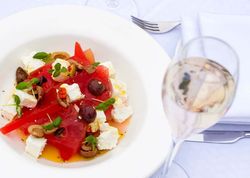
Watermelon and Feta Salad
Ingredients
- ¼ Watermelon skin removed and diced 1 inch thick
- 200 g Feta diced or crumbled
- 50 g Kalamata olives pitted
- 1 Red chilli finely chopped
- 10 ml Olive oil
- 1 clove Garlic
- Thyme a sprig
- Rosemary a sprig
- ½ Large lemon remove rind and julienne (slice rind into thin strips). Juice the flesh
- 10 g Basil leaves
- 10 g Mint leaves
- Salt & pepper to taste
Instructions
- To make the dressing, slowly and carefully heat olive oil, adding the garlic, chilli, thyme, rosemary and lemon rind.
- Gently heat for three minutes, add lemon juice, salt and pepper. It’s important to do this slowly to avoid burning any of the added elements. Set aside to cool.
- To serve, spread the diced watermelon in the desired dish, sprinkle the feta on top, spoon over olives and distribute the dressing evenly.
- Finish with a fine chiffonade of basil and mint: this will bring out all the flavour.
After Dinner Mint Cupcakes Recipe
For the Alzheimer’s Society’s Cupcake Day (17th June), Joy Skipper’s after dinner mint cupcakes recipe intends to help inspire people to get involved with the vital fundraising event. They’re also a perfect picnic staple.
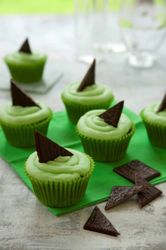
After Dinner Mint Cupcakes
Equipment
- 12-hole muffin tin
- 12 paper cases
Ingredients
- 100 g unsalted butter softened
- 175 g caster sugar
- 1 large egg beaten
- 150 g self-raising flour sifted
- 50 g cocoa powder sifted
- 100 ml milk
- 6 after dinner mints cut into quarters, on the diagonal
For the topping
- 125 g unsalted butter softened
- 200 g icing sugar sifted
- few drops peppermint flavouring
- few drops mint green food colouring
- 6 after dinner mints cut in half, on the diagonal
Instructions
- Preheat the oven to 180°C, 160°C fan, Gas mark 5. Line a 12-hole muffin tin with 12 paper cases.
- Cream together the butter and sugar until light and fluffy.
- Beat in the egg a little at a time, adding a little flour if the mixture starts to curdle.
- Fold in the flour and cocoa powder, then add the milk, to give a dropping consistency.
- Spoon 2 tsp of the mixture into each paper case. Top with 2 quarters of the chocolate mint then divide the remaining mixture between the cupcake cases. Bake for 20-25 minutes, until risen and springy to the touch.
- Remove from the oven then remove from the tin and allow to cool complete on a cooling rack.
- To make the icing, beat together the butter and icing sugar, until creamy. Add the mint flavouring and green colouring a few drops at a time until you have the flavour and colour you like.
- You can either pipe or spread the icing onto the cupcakes, then top each one with half of a mint chocolate.
Notes
Chocolate & beetroot brownies
These chocolate and beetroot brownies combine two unexpectedly complementary flavours, from chef Hugh Fearnley-Whittingstal.
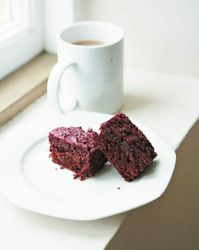
Chocolate & Beetroot Brownies
Ingredients
- 250 g Unsalted butter cut into cubes
- 250 g Dark chocolate broken into pieces
- 3 Medium eggs
- 250 g Caster sugar
- Sea salt a pinch
- 150 g Self-raising flour wholemeal ideally but white works well too
- 250 g Beetroot boiled until tender, cooled, peeled and grated
Instructions
- Grease a shallow baking tin, approximately 20 x 25cm, and line the base with baking parchment.
- Put the butter and chocolate in a heatproof bowl. Set the oven at 180°C/Gas Mark 4 and put the bowl in it for a few minutes until the chocolate and butter start to melt.
- Stir, then put back in to the oven for a few more minutes to melt completely. Of course, you could melt them together in the traditional way, over a pan of hot water, but it is a shame not to exploit the warming oven.
- Whisk the eggs and sugar together in a large bowl until combined then beat in the melted chocolate and butter until smooth.
- Combine the salt with the flour, sift them over the chocolate mixture, then gently fold in with a large metal spoon. Fold in the grated beetroot – be careful not to over-mix or it will make the brownies tough.
- Pour the mixture into the prepared tin and smooth the top with a spatula. Bake for 20 – 25 minutes; when the brownies are done, a knife or skewer inserted in the centre should come out with a few moist crumbs clinging to it.
- Don’t be tempted to overcook them or they will be dry. Remove the tin from the oven and leave on a wire rack to cool before cutting in to squares.
RELATED: These are the best canned cocktails

